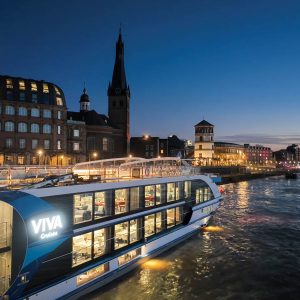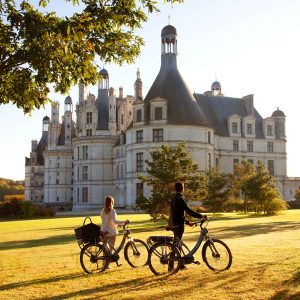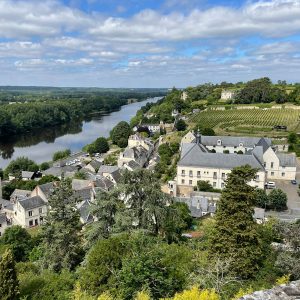Regent Holidays has specialised in arranging tours to the Balkans, Baltics, Eastern Europe & Russia for over 40 years. Alison White first joined Regent Holidays in 1987 and has had a long association with the company since then, travelling to many Regent destinations. In 1998 she moved to the USA with her husband and children, living in Illinois and California and managed to visit 28 of the 50 states. She returned to the UK in 2004 and came back to the Regent Bristol office as Marketing Manager. Since her return to the company in 2004, she has toured Bosnia-Herzegovina, Hungary, Russia, Slovenia, Estonia & Iceland.
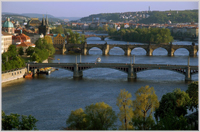 My first trip to Prague was back in the ‘cold war’ winter of 1988, when it was the capital city of the then Czechoslovakia and was firmly under communist rule. Staying in a rather large impersonal hotel, my austere soviet-style room overlooked the frozen River Vltava. On the opposite banks of the river stood an imposing bronze statue of Lenin that must have been at least 25 foot high. In the evenings we walked with virgin snow crunching underfoot across the empty cobbled streets and along to Charles Bridge, the wonderful stone structure that dates from the 14th century and links the splendour of the Staré Mesto (Old Town) with the more subtle pleasures of the Malá Strana (“lesser quarter”). The bridge was deserted, with the exception of a little old man who was selling woollen hats and mittens and an assortment of hand-carved dolls from a wooden stall.
My first trip to Prague was back in the ‘cold war’ winter of 1988, when it was the capital city of the then Czechoslovakia and was firmly under communist rule. Staying in a rather large impersonal hotel, my austere soviet-style room overlooked the frozen River Vltava. On the opposite banks of the river stood an imposing bronze statue of Lenin that must have been at least 25 foot high. In the evenings we walked with virgin snow crunching underfoot across the empty cobbled streets and along to Charles Bridge, the wonderful stone structure that dates from the 14th century and links the splendour of the Staré Mesto (Old Town) with the more subtle pleasures of the Malá Strana (“lesser quarter”). The bridge was deserted, with the exception of a little old man who was selling woollen hats and mittens and an assortment of hand-carved dolls from a wooden stall.
Just a year later, everything was to change, when on November 17th 1989, the peaceful ‘Velvet Revolution’ saw the overthrow of the communist regime and brought back democracy and freedom to the Czech People after fifty years of oppression it had endured from both Nazi occupation and communist rule. A month later on December 29th, Vaclav Havel, a dissident and playwright, well-known for his anti-communist opinions became the President of Czechoslovakia and in June 1990, the first democratic elections since 1946 were held. On January 1st 1993, Czechoslovakia split and The Czech Republic and Slovakia were created as two separate countries.
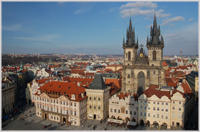 I visited Prague about a dozen times over the 20+ years that followed and on each visit I witnessed changes both good and bad, as the country became more and more westernised and progressive and embraced its new found democracy. Prague now attracts in excess of four million visitors a year and its narrow cobblestone streets and winding medieval alleyways sometimes lose some of their charm in the swarm of tourists who come to pay homage to some of the finest Baroque, Art Nouveau and Cubist buildings in Europe. However, despite the crowds, it is easy to see why Prague is still the jewel in the crown of East European capitals. In summer the city buzzes with street theatre and open-air cafes; autumn mists give it a romantic haze; in winter the Christmas Markets equal any in Germany and the Prague Spring Festival dominates May.
I visited Prague about a dozen times over the 20+ years that followed and on each visit I witnessed changes both good and bad, as the country became more and more westernised and progressive and embraced its new found democracy. Prague now attracts in excess of four million visitors a year and its narrow cobblestone streets and winding medieval alleyways sometimes lose some of their charm in the swarm of tourists who come to pay homage to some of the finest Baroque, Art Nouveau and Cubist buildings in Europe. However, despite the crowds, it is easy to see why Prague is still the jewel in the crown of East European capitals. In summer the city buzzes with street theatre and open-air cafes; autumn mists give it a romantic haze; in winter the Christmas Markets equal any in Germany and the Prague Spring Festival dominates May.
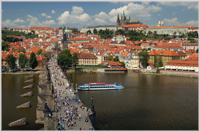 Whilst Prague, is undoubtedly a popular and busy city, you can still find gems in which to stay and eat such as the sophisticated and elegant 4 star Leonardo Hotel, situated just a few steps from Charles Bridge and tastefully furnished with antiques reflecting Prague’s rich heritage. For a taste of true Czech cuisine, great value and atmosphere, I’d recommend The Sko?epka Restaurant. Situated in an historical neo-Renaissance building, it was the former home of Max Brod, famed literary & music critic (who discovered the famous Czech composer Janá?ek) and closest friend and biographer of Franz Kafka. At Sko?epka, for about £10 a head, you can enjoy a 3 course feast with a choice of such main course delights as ‘Moldavian duck’, ‘piggy’s smoked knee’ or ‘Old Bohemian beef with dumplings’ and end your meal with the house speciality ‘ A Caramel Kiss’!
Whilst Prague, is undoubtedly a popular and busy city, you can still find gems in which to stay and eat such as the sophisticated and elegant 4 star Leonardo Hotel, situated just a few steps from Charles Bridge and tastefully furnished with antiques reflecting Prague’s rich heritage. For a taste of true Czech cuisine, great value and atmosphere, I’d recommend The Sko?epka Restaurant. Situated in an historical neo-Renaissance building, it was the former home of Max Brod, famed literary & music critic (who discovered the famous Czech composer Janá?ek) and closest friend and biographer of Franz Kafka. At Sko?epka, for about £10 a head, you can enjoy a 3 course feast with a choice of such main course delights as ‘Moldavian duck’, ‘piggy’s smoked knee’ or ‘Old Bohemian beef with dumplings’ and end your meal with the house speciality ‘ A Caramel Kiss’!
Although, Czech Airlines, the country’s national carrier ceased operating a direct service from the UK in October last year, Prague is still an easy city to reach in just a short 2 hour flight. British Airways continue to operate a regular service flying several times daily from London Heathrow and there are also low-cost carriers to choose from, such as Easyjet from Bristol, Robin Hood Airport Doncaster-Sheffield, London Stansted and Gatwick and Wizz Air from Luton.
Additional information
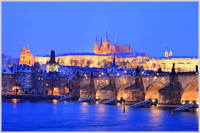 Prague has 1,160,000 inhabitants. It is the capital of the relatively small Czech Republic with about 10 million inhabitants, which is situated in the heart of Europe among Germany, Poland, Slovakia and Austria. Its traffic channels with the whole world are excellent.
Prague has 1,160,000 inhabitants. It is the capital of the relatively small Czech Republic with about 10 million inhabitants, which is situated in the heart of Europe among Germany, Poland, Slovakia and Austria. Its traffic channels with the whole world are excellent.
Even in the past, Prague was famous for its beauty and wealth – it was called “golden”, “hundred-spired”, “city of music” or “the heart of Europe”. Many prominent personalities professed their fascination by its beauty: W. A. Mozart, L. van Beethoven, G. Apollinaire, P. I. Tchaikovsky, F. M. Dostoyevsky, A. Rodin, F. Kafka, as well as Pope John Paul II or the British Queen Elisabeth II.
Prague is a city with more than one thousand years’ history, which began by the construction of Prague Castle in the late 9th century. In the 10th century, Vyšehrad Castle – the second Prague castle and the temporary seat of Bohemian princes – was built on the opposite Vltava bank. 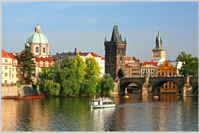 It was here, where according to the ancient legend, Bohemian Princess Libuše prophesied the future glory of Prague: “ … I see a great city, whose glory touches the stars…“ She was right. Charles IV, King of Bohemia and Emperor of the Holy Roman Empire chose Prague as the capital of the Empire. At that time, Prague enjoyed its biggest efflorescence. For the second time, Prague became the European centre of education and culture in the period of the rule of Rudolph II. The appearance of the city was markedly influenced by the Baroque period, but other epochs left behind them precious documents of building skill and art of all other architectural styles as well. Visitors from around the world are attracted by unique symbiosis of preserved monuments of all architectural styles: Romanesque rotundas, Gothic and Baroque churches, Renaissance palaces and gardens, Art Nouveau, Cubist and Modern buildings.
It was here, where according to the ancient legend, Bohemian Princess Libuše prophesied the future glory of Prague: “ … I see a great city, whose glory touches the stars…“ She was right. Charles IV, King of Bohemia and Emperor of the Holy Roman Empire chose Prague as the capital of the Empire. At that time, Prague enjoyed its biggest efflorescence. For the second time, Prague became the European centre of education and culture in the period of the rule of Rudolph II. The appearance of the city was markedly influenced by the Baroque period, but other epochs left behind them precious documents of building skill and art of all other architectural styles as well. Visitors from around the world are attracted by unique symbiosis of preserved monuments of all architectural styles: Romanesque rotundas, Gothic and Baroque churches, Renaissance palaces and gardens, Art Nouveau, Cubist and Modern buildings.
Since 1992, the historic Prague centre extending over an area of 866 hectares has been included in the UNESCO World Cultural and Natural Heritage. There are 1283 immovable cultural monuments here and other 1500 monuments are situated outside of the historical centre.
Images copyright of Prague Information Service and their website.

